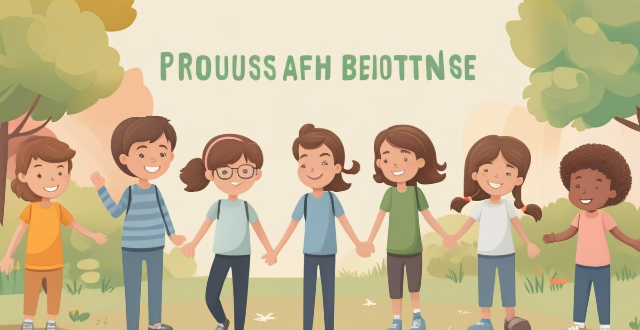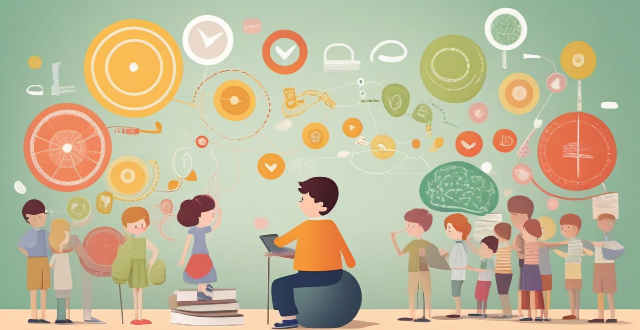Climate Children

What role do children play in combating climate change ?
The article emphasizes the pivotal role children can play in combating climate change. They can contribute through education and awareness, innovation and creativity, advocacy and action, and by making sustainable lifestyle changes. By empowering children to understand and act on climate issues, we can ensure a more sustainable future for all.

What actions should parents take to protect their children from climate change ?
Parents should educate themselves and their children on climate change, adopt sustainable living practices, support clean energy, conserve natural habitats, make healthy lifestyle choices, get involved in community initiatives, and prepare homes and communities for extreme weather events to protect their children from the impacts of climate change.

What are the benefits of teaching children about climate change ?
Teaching children about climate change is crucial for their future, empowering them to take action and make a difference. It enhances their awareness, critical thinking skills, environmental stewardship, innovation, preparation for future careers, empathy, responsibility, healthy habits, resilience, and interest in science and technology. This education can lead to informed decision-making, problem-solving abilities, responsible behavior towards the environment, and a sense of global citizenship. By teaching children about climate change, we are preparing them to confront one of the most significant challenges facing our planet.

How can children become advocates for climate change mitigation ?
Children can play a pivotal role in advocating for climate change mitigation. They can start by understanding the basics of climate change through educational programs and applying what they learn in their actions such as reducing waste, reusing items, recycling, and planting trees. Community engagement activities like clean-up drives and promoting sustainable practices also help in raising awareness. Children can use social media responsibly to spread information about climate action and express their views through artwork or letters to decision-makers. They can also influence decisions by meeting local leaders or participating in youth councils. Collaboration with peers and NGOs helps in achieving larger impacts while global engagement makes them feel part of a larger movement. Personal development activities like building public speaking skills and learning about sustainability empower them further.

What are some effective ways to teach children about climate change ?
Teaching children about climate change is crucial for their future and the planet's well-being. Here are some effective ways to educate them on this important topic: 1. Use age-appropriate language that they can understand, avoiding complex scientific terms. 2. Incorporate interactive learning through games or experiments that demonstrate the effects of climate change. 3. Discuss real-life examples of climate change, such as extreme weather events like hurricanes, floods, and droughts. 4. Encourage critical thinking by asking open-ended questions about climate change and encouraging problem-solving skills. 5. Involve children in solutions by participating in community clean-up events, planting trees, or reducing energy consumption at home. 6. Integrate technology through educational apps, videos, and websites that provide engaging and informative content on climate change. 7. Foster empathy for nature by encouraging children to spend time outdoors and appreciate the beauty of the natural world. By using these effective methods, we can help children understand the importance of protecting our planet and inspire them to take action against climate change.

What are the long-term effects of climate change on children ?
Climate change has far-reaching effects on children's health, including physical, mental, and emotional impacts. Poor air quality, extreme weather events, and food insecurity can harm children's physical health. Trauma and stress from climate-related disasters, as well as fear and anxiety about the future, can affect their mental health. Loss of home and community, along with intergenerational trauma, can impact their emotional health. Addressing these challenges requires a comprehensive approach to ensure a healthier future for all children.

What are the implications of climate change for future generations, specifically children ?
Climate change poses significant challenges and threats to future generations, particularly children. The implications of climate change for children are multifaceted and far-reaching, affecting their health, safety, education, and overall well-being. Health implications include increased respiratory problems, spread of infectious diseases, and nutritional deficiencies due to extreme weather events and changing precipitation patterns. Safety risks involve natural disasters and heat stress, while education is affected by disruption of learning and limited access to educational resources. Overall well-being implications include mental health issues, loss of cultural heritage, and economic impacts on families and communities. Addressing these challenges requires urgent action to mitigate the effects of climate change and adapt to its inevitable consequences, ensuring a healthier, safer, and more equitable future for all children.

What are some effective strategies for teaching climate change to young children ?
Teaching climate change to young children can be a daunting task, but it is crucial to help them understand the impact of their actions on the environment. Here are some effective strategies for teaching climate change to young children: Start with simple explanations, use visual aids, encourage hands-on learning, involve them in environmental activities, use storytelling, discuss solutions, make it relevant to their lives, and encourage critical thinking.

What initiatives are being taken globally to include children in climate action planning ?
Including children in climate action planning is crucial for several reasons. Firstly, it acknowledges their rights and provides them with a platform to voice their concerns about the environment. Secondly, it encourages intergenerational dialogue and collaboration, which can lead to more effective solutions. Finally, involving children in climate action planning helps them develop critical thinking skills, empathy, and a sense of responsibility towards the planet. Here are some initiatives that are being taken globally to include children in climate action planning: 1. UNICEF's Child-Friendly Cities Initiative 2. The Global Kids Climate Forum 3. The Youth4Climate Movement 4. The Fridays for Future Movement 5. The Climate Change Education Programme (CCEP) 6. The Earth Guardians Programme 7. The Eco-Schools Programme 8. The Children's Climate Prize 9. The Global Youth Biodiversity Network (GYBN) 10. The Youth Environmental Leadership Programme (YELP)

What are the psychological impacts of climate change on children ?
The psychological impacts of climate change on children can be significant and far-reaching, including anxiety and fear, a sense of helplessness, loss of connection to nature, trauma, and grief and mourning. It is essential for parents, educators, and mental health professionals to recognize and address these impacts to support the mental health and well-being of children affected by climate change.

What are the psychological effects of climate change on children, and how can their mental health rights be protected ?
The psychological effects of climate change on children are significant and can include anxiety, fear, depression, trauma, and grief. To protect children's mental health rights, it is important to educate them about climate change, provide access to mental health services, create safe spaces for expression, and encourage advocacy and action.

How does air pollution caused by climate change affect children ?
The provided text discusses the impact of air pollution, exacerbated by climate change, on children's health. It outlines both immediate and long-term health effects, including respiratory issues, developmental concerns, chronic conditions, and potential for other health problems. The text also highlights the socio-economic impact of these health issues, such as school performance and healthcare costs. Prevention and mitigation strategies are suggested, including reducing pollution sources, promoting clean energy, awareness and education, and urban planning. The conclusion emphasizes the need for collective action to protect children's health and future.

What is the impact of climate change on children's access to education ?
Climate change affects children's access to education through extreme weather events, health impacts, food security issues, and displacement and migration. These challenges make it difficult for children to attend school or continue their studies. It is crucial to take action now to mitigate the effects of climate change and protect the future of education.

In what ways can we ensure that children's voices are heard in climate policy decisions ?
This text discusses the importance of including children's perspectives in climate policy decisions. It emphasizes the long-term impact of climate change on future generations and the need for intergenerational equity. The article suggests ways to incorporate children's voices, such as education and awareness, direct involvement, accessibility and inclusivity, feedback mechanisms, and collaboration and partnerships. It concludes by emphasizing the benefits of involving children in climate policy decisions and ensuring their voices are heard and valued.

How does climate change affect children's rights to a healthy environment ?
This article explores the impact of climate change on children's right to a healthy environment, highlighting various health, nutritional, psychological, and educational implications. It emphasizes that addressing climate change is crucial for safeguarding children's rights and future well-being.

How can we protect children from the adverse effects of climate change ?
Climate change poses significant threats to children's well-being, affecting their health, education, nutrition, and mental health. To protect them, we can focus on education and awareness, health protection, nutrition and food security, mental health support, and infrastructure and urban planning. This includes integrating climate change education into school curriculums, engaging communities in workshops, ensuring safe housing and air quality, improving healthcare accessibility and vaccination programs, establishing school gardens and supporting local farmers, providing counseling services and community support networks, and developing resilient infrastructure and safe public spaces.

How can children be empowered to participate in climate activism while protecting their rights ?
This discussion explores strategies to empower children in climate activism while safeguarding their rights. The key strategies include education and awareness, safe participation, protection of rights, and community engagement. Education and awareness can be achieved through informative workshops and accessible information. Safe participation involves age-appropriate activities and adult supervision. Protection of rights includes respect for privacy, psychological support, and legal advocacy. Community engagement can be fostered through youth-led initiatives, networking opportunities, and family involvement. By focusing on these strategies, we can empower children to participate in climate activism while ensuring their rights are protected.

What are the implications of climate change on the education and well-being of children worldwide ?
Climate change has significant impacts on the education and well-being of children worldwide. These impacts include disruption of education due to school closures and migration, health issues related to increased heatwaves and air quality problems, nutritional deficiencies from crop failures and food insecurity, psychological stress from natural disasters and anxiety about the future, loss of playgrounds and outdoor learning spaces, and socioeconomic impacts such as economic hardship and inequality in educational opportunities. Addressing these challenges requires a comprehensive approach that involves mitigating the effects of climate change and adapting educational systems to be more resilient.

How can international laws and treaties on children's rights be adapted to include protections against the impacts of climate change ?
Adapting international children's rights laws for climate change is crucial and can be achieved by recognizing the intersectionality of climate change and children's rights, strengthening legal frameworks, enhancing implementation and monitoring mechanisms, promoting education and awareness, advocating for child participation, and investing in research and data collection.

How can we educate children about climate change ?
Educating children about climate change is crucial for the future of our planet. Here are some ways we can educate them: 1. Start by teaching basic science concepts like the greenhouse effect, carbon dioxide emissions, and the role of fossil fuels. 2. Use visual aids and interactive tools like charts, graphs, videos, and online games or simulations to make learning more engaging and fun. 3. Encourage hands-on learning through experiments and projects that demonstrate the effects of climate change on local ecosystems. 4. Involve them in community action projects like tree planting, beach cleanups, and advocacy campaigns to inspire responsibility for protecting the environment. 5. Foster a culture of sustainability at home by reducing energy consumption, using public transportation, and supporting local farmers.

How does climate change affect children's mental wellbeing ?
Climate change has a significant impact on children's mental wellbeing, leading to anxiety, fear, emotional distress, grief, and loss. However, by educating children about the issue, providing access to mental health services, and building strong communities, we can help mitigate these effects and support children's overall wellbeing.

What role do schools play in educating children about their rights in the context of climate action ?
Schools play a crucial role in educating children about their rights, especially regarding climate action. They are responsible for providing academic knowledge and shaping the values, attitudes, and behaviors of future generations. In the face of the climate crisis, schools have the opportunity to empower students by teaching them about their rights and responsibilities related to environmental protection. The importance of climate education includes raising awareness and understanding, promoting rights-based learning, fostering responsibility and accountability, and developing critical thinking and problem-solving skills. Integrating climate education into the school curriculum involves a cross-curricular approach, project-based learning, extracurricular activities, community engagement, and implementing green school initiatives and supportive policies. By doing so, schools can empower students to become informed, responsible citizens who are equipped to tackle the climate crisis head-on.

In what ways do children contribute to climate change ?
Children contribute to climate change through increased energy consumption, resource use, transportation emissions, food choices, lack of education, population growth, consumer behavior, inheritance of unsustainable practices, urbanization, and loss of natural habitats.

How can parents promote healthy developmental milestones in their children ?
This article provides tips for parents on how to promote healthy developmental milestones in their children, including providing a stimulating environment, encouraging social interaction and physical activity, teaching self-care skills, and fostering independence.

What are the best travel destinations for families with young children ?
Traveling with young children can be a rewarding experience, but it's important to choose destinations that cater to the needs and interests of both kids and adults. Here are some of the best travel destinations for families with young children: 1. Disney World, Florida - an iconic family vacation destination that offers something for everyone. With four parks and two water parks, there's no shortage of fun activities for kids of all ages. From meeting beloved characters like Mickey Mouse and Elsa from Frozen to thrilling rides like Space Mountain and Tower of Terror, Disney World has it all. 2. San Diego, California - a great destination for families with young children because of its mild climate and abundance of kid-friendly attractions. The San Diego Zoo is a must-visit, as well as the nearby Legoland theme park. Other popular attractions include the beachfront boardwalk in Mission Beach and the interactive museum at the Fleet Science Center. 3. Yellowstone National Park, Wyoming/Montana/Idaho - For families who enjoy outdoor adventures, Yellowstone National Park is a fantastic destination. With its stunning natural beauty, wildlife viewing opportunities, and geothermal wonders like Old Faithful, Yellowstone is a great place to introduce kids to nature and conservation. There are also plenty of hiking trails and ranger-led programs that are perfect for families with young children. 4. New York City, New York - may not seem like an obvious choice for families with young children, but there are plenty of kid-friendly attractions in this bustling metropolis. Visit the American Museum of Natural History or the Children's Museum of Manhattan for educational fun, take a ferry ride to see the Statue of Liberty, or catch a Broadway show designed specifically for kids. And don't forget about Central Park – it's an oasis in the heart of the city where kids can run around and play while parents relax on the grassy lawns. 5. Hawaii - is a paradise that offers something for everyone in the family. With its warm weather and beautiful beaches, it's the perfect place to relax and unwind. But there are also plenty of adventurous activities like surfing lessons, snorkeling excursions, and hiking trails that will keep kids entertained. Plus, Hawaiian culture is rich and unique, offering opportunities for families to learn about local traditions and history.

How can parents effectively teach their children about safety ?
Teaching children about safety is crucial for their well-being. Parents can effectively teach their children about safety by establishing clear rules, educating them about potential dangers, practicing safety drills, encouraging open communication, and modeling safe behavior. By doing so, children will develop awareness and the ability to protect themselves from potential dangers.

How is climate change affecting children's health ?
The text discusses the impacts of climate change on children's health, which are both direct and indirect. Direct effects include increased respiratory issues due to pollen and allergens, vector-borne diseases, heat-related illnesses, and nutritional deficiencies. Indirect effects encompass mental health challenges like trauma and displacement, educational disruptions such as school closures, and social and emotional development issues. The conclusion emphasizes the need for immediate attention and interventions to address these challenges, focusing on strengthening children's resilience through healthcare, educational support, and nurturing environments.

How do I provide for minor children in my estate plan ?
When it comes to estate planning, one of the most important considerations is how to provide for your minor children. Here are some steps you can take to ensure that your children are taken care of financially and emotionally after you're gone: Create a will or trust, name a guardian, establish a trust fund, consider life insurance, and make sure your beneficiaries are up-to-date.

How can children be encouraged to speak up if they feel unsafe ?
The article emphasizes the importance of creating a safe and supportive environment for children to express themselves without fear of judgment or criticism. It suggests educating children about personal safety, role-playing different scenarios, and discussing potential consequences of not speaking up if they feel unsafe. The article also recommends teaching children who to trust, encouraging them to use their voice, and providing options for seeking help. Overall, it highlights the significance of empowering children to take action and advocate for their own safety.